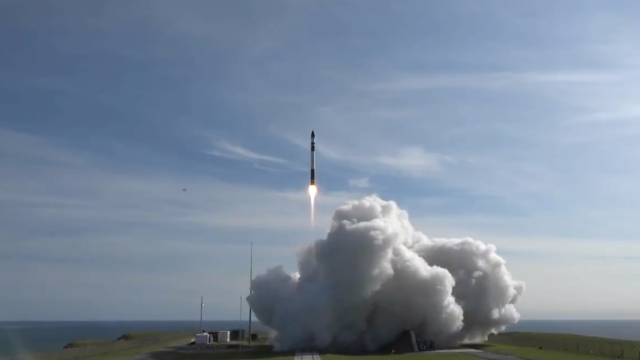U.S.-based aerospace manufacturer Rocket Lab completed its first successful commercial launch on Saturday, sending seven spacecraft including “six tiny satellites and a drag sail demonstrator” into orbit aboard a relatively small Electron rocket designed primarily for smallsats and cubesats, Spaceflight Now reported.
Rocket Lab’s second orbital Electron mission #ItsBusinessTime. A successful launch and more payloads on orbit. We’re opening access to space. pic.twitter.com/0HgJ1aNtdS
— Rocket Lab (@RocketLab) November 11, 2018
According to the report, the two-stage, $US5.7 ($8) million Electron rocket launched from Rocket Lab’s complex in New Zealand, with its nine main engines powered by kerosene:
The two-stage rocket, standing more than 55 feet (17 meters) tall, fired its nine kerosene-fuelled Rutherford main engines at 0350 GMT Sunday (10:50 p.m. EST Saturday) and climbed away from Launch Complex 1, Rocket Lab’s privately-operated spaceport on Mahia Peninsula, located on the east coast of New Zealand’s North Island.
The Electron arced toward the south from Mahia Peninsula, riding nearly 22,680kg of thrust from the Rutherford engines during a two-and-a-half minute first stage burn.
After the rocket’s booster separated from the second stage and fell into the open, the second stage’s single Rutherford engine (a mostly 3D-printed design with an electric-pump-fed engine) took the rest of the payload into orbit. A final stage delivered the payloads into orbit, SpaceFlight now reported:
Rocket Lab’s Curie kick stage deployed from the Electron second stage around nine minutes after liftoff, in an elliptical parking orbit with a low point around 120 miles (200 kilometers) and a high point around 499km (500 kilometers) above Earth, and an inclination of 85 degrees.
The Curie kick stage soared over Antarctica, then flew north over the Atlantic Ocean before igniting its main engine, which burns a “green” non-toxic liquid monopropellant. A burn lasting nearly two minutes aimed to circularize the kick stage’s orbit at an altitude of around 499km before release of the mission’s six satellite passengers.
As CNBC noted, the Electron rocket is designed to carry spacecraft up to the size of a refrigerator on a faster timetable than larger competitors like SpaceX’s Falcon 9 rockets, though it actually costs more than the latter. On Saturday, it carried satellites for Spire, Tyvak, Fleet and the Irvine CubeSat STEM program, as well as the drag sail demonstrator, which is a prototype for technology to clear some of the debris in orbit around the Earth.
While Rocket Lab made its first orbital launch in January, this attempt was delayed due to a “motor control” issue with the rocket that has since been fixed, CNBC wrote. Now that the issue has been resolved, Rocket Lab has a backlog of launches in the next 18 months that CEO Peter Beck told CNBC is “around a $US3 ($4) billion pipeline,” and it hopes to be launching once a week by 2020. SpaceFlight Now reported the next launch will be somewhere between Dec. 10 and Dec. 18, 2018, citing sources with payloads on the rocket.
